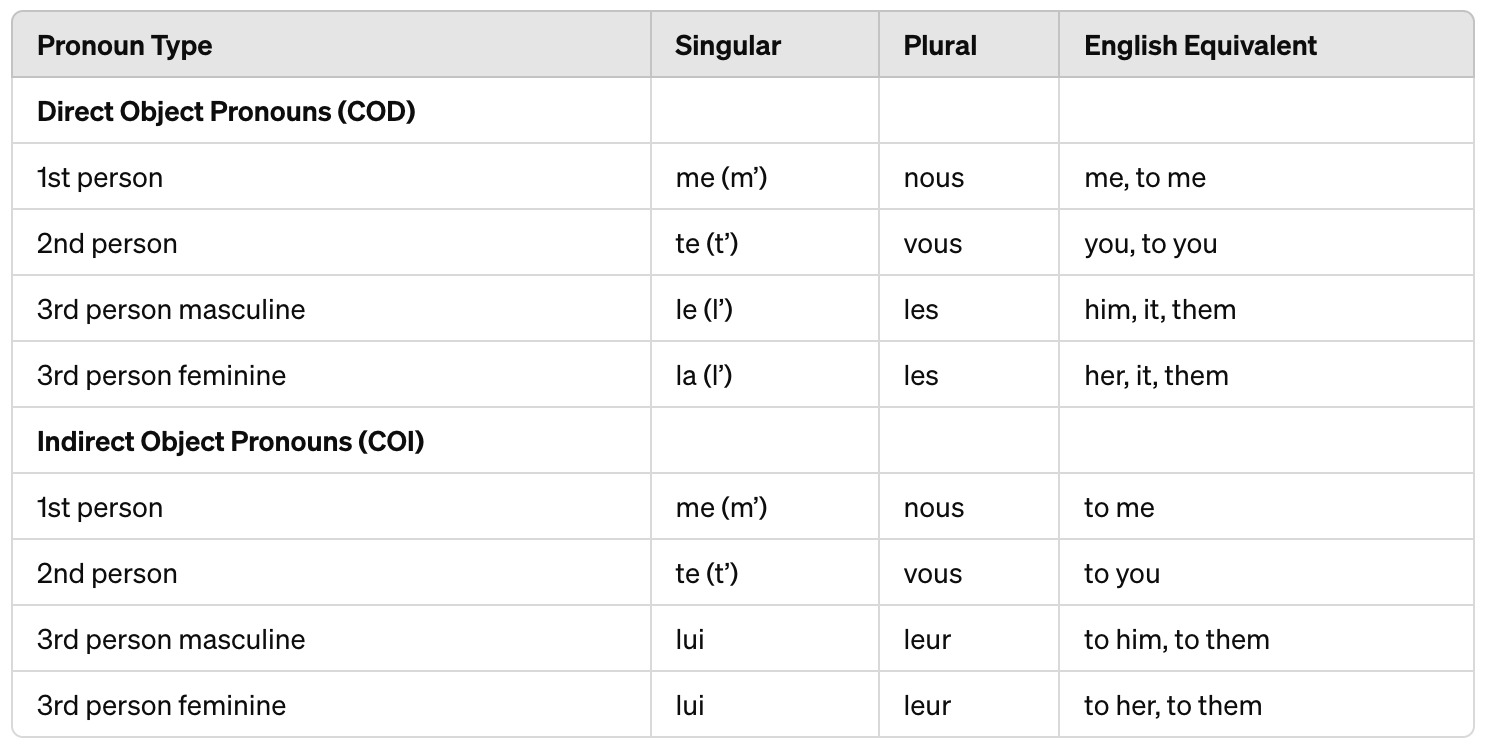Interactions in French
lesson 1 ⎥ lesson 2 ⎥ lesson 3 ⎥ lesson 4 ⎥ lesson 5 ⎥ lesson 6 ⎥ lesson 7
Introduction to French Object Pronouns
Replace with the Correct Pronoun (COD or COI)
Determine whether to replace with a direct or indirect object pronoun and complete the sentence.
Welcome to our comprehensive lesson on French object pronouns! In this tutorial, we will delve into the use of direct (COD – Complément d’Objet Direct) and indirect object pronouns (COI – Complément d’Objet Indirect), which are essential for speaking and writing French fluently and accurately. These pronouns are fundamental in avoiding repetition and enhancing the cohesion of discourse.
Let’s start by listening to the dialogue and then answer the comprehension questions.
Dialogue Overview and Translation
listening to the dialogue and then answer the comprehension questions.
Vocabulary and Phrases
- Nouvelle ici – new here
- Arrivée – arrived
- Fonctionnement – functioning, how things work
- Médiathèque – media library
- Famille d’accueil – host family
- Secrétariat – secretary’s office
- Dossier d’inscription – registration file
- Formulaire – form
Key Phrases for Communication
- Asking about experiences: Tu la trouves comment ? What do you think of it?
- Describing impressions: Tout le monde est très gentil. Everyone is very kind.
- Clarifying locations: Le secrétariat est derrière toi. The secretary’s office is behind you.
- Offering assistance: Tu me téléphones, je te montrerai la médiathèque. Call me, I’ll show you the library.
Explanation of Direct and Indirect Object Pronouns in French
In the French language, understanding the roles of direct object pronouns (COD – Complément d’Objet Direct) and indirect object pronouns (COI – Complément d’Objet Indirect) is crucial for mastering sentence structure. These pronouns help to avoid repetition and make conversations flow more smoothly.
French Direct Object Pronouns (COD)
Direct object pronouns replace nouns directly affected by the verb without the preposition. They answer the questions “what?” or “whom?” directly after the verb.
Examples from the Dialogue
- “L’école, tu la trouves comment ?”
- Here, “la” replaces “l’école” (the school), which is the direct object of the verb “trouves” (find).
- “Je les ai trouvés vraiment compétents.”
- “Les” refers to “les gens de l’accueil” (the reception staff), the direct objects of the verb “ai trouvés” (found).
- “Oui, je l’ai vue, mais je ne l’ai pas visitée.”
- “L'” replaces “la médiathèque” (the library), the direct object of the verbs “ai vue” (saw) and “ai visitée” (visited).
Indirect Object Pronouns (COI)
Indirect object pronouns replace nouns that are indirectly affected by the verb, typically introduced by a preposition such as “à” (to). They answer the question “to whom?” or “for whom?”
Examples from the Dialogue
- “Les gens de l’accueil m’ont expliqué le fonctionnement de l’école en détail.”
- M’ (me) is the indirect object pronoun for “moi,” indicating that the explanation was given to me.
- “Est-ce qu’ils t’ont montré la médiathèque ?”
- T’ (you) indicates that the action of showing was done to you.
- “Je te donne mon numéro.”
- Te (you) is the indirect object pronoun, indicating that the number is being given to you.
- “Tu me téléphones.”
- Me (me) indicates that the action of calling is directed towards me.
- “Je te montrerai la médiathèque.”
- “Te” (you) here again indicates that the showing will be done for you.
Additional Examples
Here are some more sentences illustrating the use of COD and COI pronouns:
- COD: Il la regarde. He is looking at her.
- COI: Il lui parle.” He is talking to him/her.
🍀 Table of French Object Pronouns : Direct and Indirect 🍀
Usage Notes
- Direct Object Pronouns (COD) replace the nouns directly affected by the verb without a preposition. They are used when the verb acts directly on the noun, e.g., “Je vois la voiture” (I see the car) becomes “Je la vois” (I see it).
- Indirect Object Pronouns (COI) replace nouns that are indirectly affected by the verb, typically those introduced by the preposition “à”. They are used when the verb acts on the noun through an intermediary, e.g., “Je parle à Jean” (I speak to Jean) becomes “Je lui parle” (I speak to him).
✚ Agreement of Past Participles in Passé Composé
Introduction
The agreement of past participles in the passé composé is a crucial aspect of French grammar that often confuses learners. This agreement depends on the direct object’s position and the auxiliary verb used (être or avoir).
Rules for Agreement
- With “être” as Auxiliary: The past participle agrees in gender and number with the subject of the verb.
- With “avoir” as Auxiliary: The past participle generally does not agree with the subject but may agree with a preceding direct object.
Examples from the Dialogue
- “Je suis arrivée lundi.”
- Arrivée agrees with the subject “je” (Nana, who is female), reflecting the use of “être” as the auxiliary.
- “Les gens de l’accueil m’ont expliqué le fonctionnement de l’école en détail.”
- Expliqué does not agree with the direct object “le fonctionnement” because it follows the verb. The auxiliary used is “avoir.”
- “Je les ai trouvés vraiment compétents.”
- Trouvés agrees in gender and number with “les” (les gens), a direct object that precedes the verb. Here, “avoir” is used, but the past participle agrees because the direct object precedes it.
Additional Examples
To solidify understanding, here are additional examples:
- Elle a mangé les pommes. She ate the apples.
- No agreement with “mangé” because “les pommes” follows the verb.
- Elle les a mangées. She ate them.
- “Mangées” agrees with “les” (feminine plural) because it precedes the verb.
Key Point
- Preceding Direct Object: If a direct object pronoun precedes the verb in passé composé with “avoir,” then the past participle must agree with it in gender and number.
Practice Exercises
Exercise 1: Replace the Direct Object (COD) with a Pronoun
Replace the direct object in each sentence with the appropriate direct object pronoun.
Exercise 2: Replace the Indirect Object (COI) with a Pronoun
Replace the indirect object in each sentence with the appropriate indirect object pronoun.
- Je parle à Marie. → Je ______ parle.
- Elle donne des fleurs à sa mère. → Elle ______ donne des fleurs.
- Nous écrivons à nos parents. → Nous ______ écrivons.
- Tu réponds à l’enseignant. → Tu ______ réponds.
- Il emprunte de l’argent à son frère. → Il ______ emprunte de l’argent.
- Vous demandez de l’aide à vos amis. → Vous ______ demandez de l’aide.
- Je raconte une histoire à mes enfants. → Je ______ raconte une histoire.
- Ils envoient des invitations à leurs collègues. → Ils ______ envoient des invitations.
- Elle explique la solution aux étudiants. → Elle ______ explique la solution.
- Vous montrez le chemin au touriste. → Vous ______ montrez le chemin.
- Ils prêtent le livre à Anna. → Ils ______ prêtent le livre.
- Je lance la balle au chien. → Je ______ lance la balle.
- Tu offres un cadeau à ton ami. → Tu ______ offres un cadeau.
- Nous servons le dîner à nos invités. → Nous ______ servons le dîner.
- Elle dit la vérité à son père. → Elle ______ dit la vérité.
Exercise 3: Replace with the Correct Pronoun (COD or COI)
Determine whether to replace with a direct or indirect object pronoun and complete the sentence.



